Types Of Tyre Damage And What To Do About Them
Tyre damage comes in many forms and levels of severity. It doesn’t matter how safe a driver you are; the chances are your tyres will suffer damage at some point in their lifetime. Whether it’s caused by potholes, debris on the road, or a road traffic incident, you should be prepared to identify and diagnose the different types of tyre damage.

The most common types of tyre damage include:
- Punctures
- Sidewall damage
- Cracks
- Irregular tread wear
- Bursts
However, each case of a damaged tyre is different. By learning more about each of the main types of tyre damage, you’ll be able to confidently figure out what’s wrong with yours and what you need to do about it.
Types of tyre damage
These are some of the main forms of tyre damage, what they’re most often caused by, and what you need to do about them to keep yourself safe on the road.

Punctures
Punctures happen when a sharp object penetrates the outer wall of your tyre. They can be caused by anything sharp on the road including shards of glass, loose nails or screws, or even cracks in tarmac.
If a puncture-causing object gets deep enough into your tyre, it can cause a loss of air pressure as an escape hole for the air inside is formed. This loss of air pressure can create a range of problems, from loss of grip with the road to reduced handling.
How to tell if you have a puncture
Punctures generally come in two main types – slow punctures and rapid punctures. Slow punctures are identifiable by inspecting your tyres. If they look misshaped or deflated, have a damaged sidewall, or noticeable debris stuck in the surface, you could have a slow puncture.
Rapid punctures are more obvious because they seriously inhibit your ability to drive. A rapid puncture will mean your tyre quickly loses air pressure, and the knock-on effects to your vehicle’s handling will be un-missable. You can then diagnose which tyre is affected by inspecting them for damage.
How to fix a punctured tyre
If you get a puncture while you’re driving, you might need to carry out a repair on the roadside. Punctured tyres can be repaired, although fixes are only temporary and you should look to replace the damaged tyre as soon as possible.
You can use tyre repair kits that employ sealant to plug the hole caused by the puncture and then re-inflate your tyre back to its optimal inflation to make sure it’s safe to drive on for the time being.
Tyre Wall Damage
Your tyre walls, or tyre sidewalls as they’re sometimes known, are the outward facing sides of your tyres, surrounding the face of the wheel rim. Tyre sidewalls are built to be strong to withstand the pressure that they’re under, but they can still be damaged in several ways.
There are two main types of tyre wall damage, bulges and cuts. Bulges are usually caused by impacts, whether from mounting a kerb or hitting a pothole. This causes the structural integrity of the tyre sidewall to weaken in the spot of the impact, and the air pressure of the tyre then causes what looks like a bubble to protrude.
Tyre sidewall cuts are also usually caused by impacts, but they’re more dangerous because they can cause blowouts. They can also be created by driving over sharp objects on the road if you have low tyre pressure, as the sidewall of under-inflated tyres could be in contact with the tarmac.
How to tell if your tyre sidewall is damaged
Both of the main forms of damage that can be caused to tyre sidewalls can be diagnosed easily enough, as they’re visible on inspection. A bulge will look like an air bubble caught underneath the surface of the sidewall while a cut will be an open slit in the sidewall.
How to repair tyre sidewall damage
Tyre wall damage isn’t the kind of thing you can repair as it significantly weakens the tyre’s structural integrity. If you find that you have bulges or cuts in your sidewall, you should drive safely to your nearest garage or use a mobile tyre replacement service to get new tyres to replace your damaged ones.

Cracks
Cracks in your tyres can appear on your tyre sidewall or, more commonly, on the surface of the tyre that’s in contact with the road. They can be caused by bad road conditions, general wear and tear, and even excess exposure to UV rays.
Although minor cracks in your tyre tread or sidewalls aren’t catastrophically dangerous in most cases, they do represent a loss in grip, reduced handling, and the chance for worse cracks and cuts if not addressed.
How to tell if your tyres are cracked
You’ll easily be able to tell if your tyres are cracked by inspecting them. Cracks can range in size from less than a millimetre thick to over a centimetre thick, and the thicker the crack is, the more important it is you change your tyre.
When you’re inspecting your tyres for cracks, make sure you check both the outside surface, inside the tread grooves, and the sidewall.
How to repair tyre cracks
Just like cuts and bulges, tyre cracks can’t be effectively repaired, meaning you should replace your tyres as soon as possible after noticing significant cracks. Cracks in your tyres will only get worse the longer you leave them and the more you continue to drive on them, so make sure you don’t forget about finding replacements.

Irregular tread wear
A less obvious form of damage to your tyres is irregular tread wear. There are several types of irregular wear, with the most common being heel and toe wear, one-sided wear, and centre wear.
All three of these types of wear can cause issues with traction and handling, and they all have different causes.
Heel and toe wear is a result of normal tyre usage, but should be addressed if it becomes serious. It’s caused by one side of the tyre tread blocks wearing faster than the other as they rub against the road surface while snapping back into their position while the tyre is rolling.
One-sided wear is caused by misalignment of the wheels on their axis and can occur on the outside or inside edge of the tyre depending which way the wheels are misaligned. It causes an uneven amount of wear on one side of the tyre which exacerbates the original misalignment.
Centre wear is when the very centre of your tyre tread wears more quickly than the rest of the tread and it’s usually caused by over-inflated tyres. The higher the air pressure within the tyre, the more the centre section of the tyre surface will protrude and take all of the force involved with being in contact with the road.
How to tell if your tyres have irregular tread wear
It’s easy to tell if your car tyres have irregularly worn treads, simply by taking a look at them. You’ll be able to tell what condition your tread is in by the prominence of your tread bars, and if there’s more wear in one part of the tyre than another, use the above information to find out which type of tread wear your tyre has.
How to fix irregular tread wear
You can’t reverse worn treads on tyres, so the only fix for irregular tread wear is to replace the affected tyres. Depending on which type of irregular tread wear your tyres have suffered, however, you might want to invest in a fix for your car that will prevent it from happening again.
Tyre burst
The most significant, and most dangerous, type of tyre damage you can sustain is a burst tyre. This is when the structural integrity of the tyre wall completely fails and the tyre loses its ability to hold air. A burst tyre has huge ramifications on a car’s ability to drive, completely altering the way it handles and making it a danger to other drivers on the road.
Tyres can burst for a number of reasons. One of the most common is under-inflation which causes the tyre to bulge out under the car’s weight, increasing friction with the road surface and therefore the heat that’s caused by driving. Particularly deep potholes can also cause tyre blowouts, resulting from the sudden increase in pressure on the tyre from having the full weight of the car thrust upon it.
How to tell if your car has a burst tyre
It’s borderline impossible not to notice if your car has a burst tyre. Firstly, you’ll most likely actually hear it burst while you’re driving as all of the air escapes at high pressure. If you don’t hear the burst, you’ll feel it immediately afterwards as the handling of your car will change suddenly as the steering is pulled in the direction of the burst tyre.
A burst tyre will look almost completely flat and will be bulging widely at the bottom, similarly to if you have a serious puncture.
How to fix a burst tyre
You can’t fix a burst tyre in any meaningful way. While theoretically you could patch up the hole that’s been created and then refill your tyre with air, it’s likely that the hole would reopen with the increased pressure almost straight away. The only solution for a burst tyre is to have it replaced with a new one.
25 Jun 2019
Did you enjoy this blog post?
|
33 people found this review helpful
